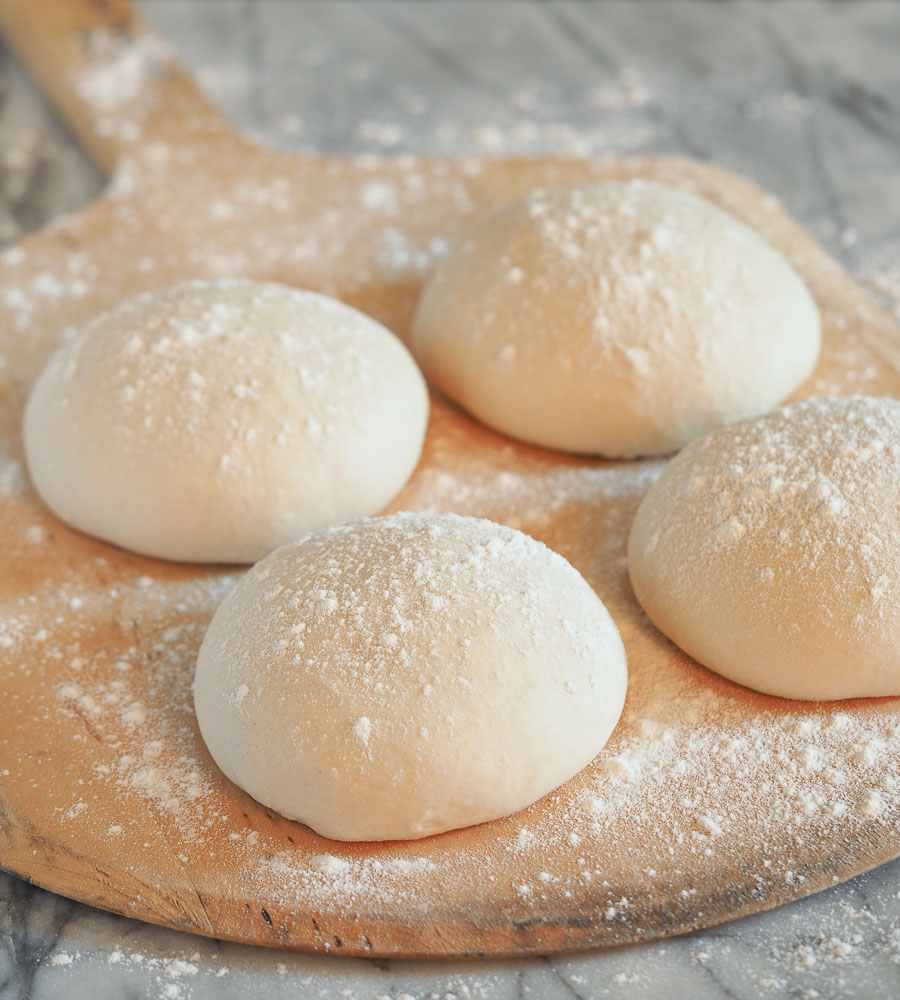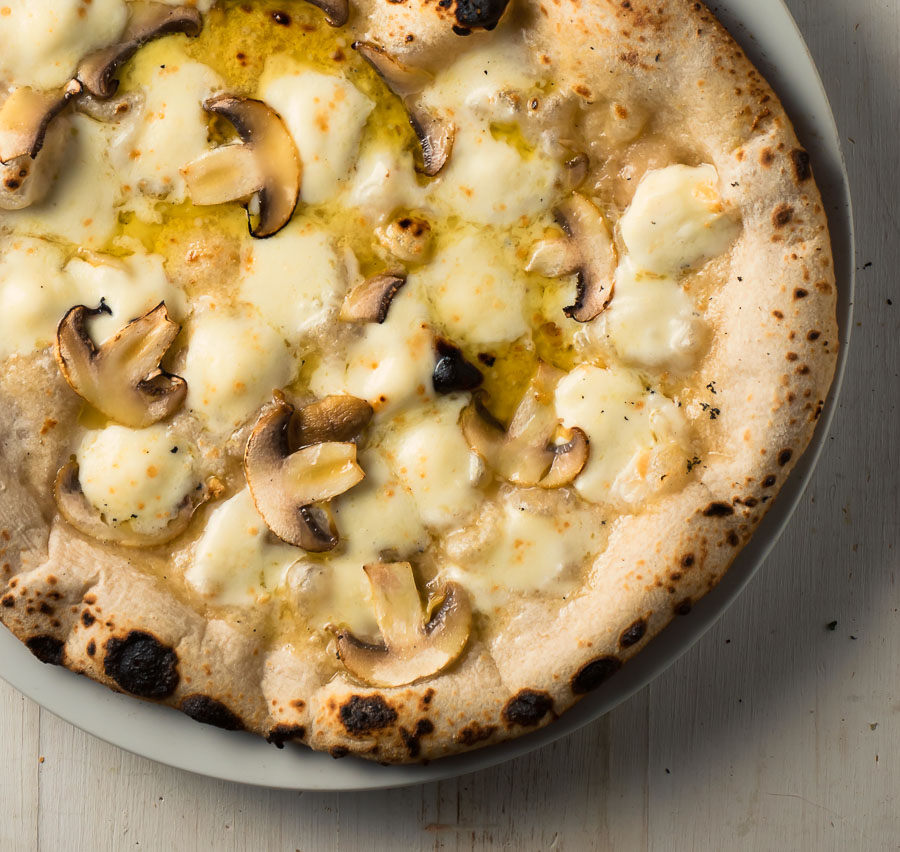Neapolitan pizza is a magical thing. The crust has a tang. Real flavour. Not that drab, everybody eats around it stuff.
And it starts with the dough. This isn’t your everyday pizza dough. Get this right and you will make better pizza than you can buy. For real.
If you want to learn about Neapolitan pizza read this post. Don’t skip to the recipe. This is not about anything except making pizza dough.
2500 words on pizza dough. Nothing else. Look at the crust on the pizzas in this post. That’s what I’m talking about…
Every pizza dough recipe out there goes something like this. Mix up some flour, water, way too much yeast, salt, oil and sugar. Proof it for a few hours. Ball it up. Make pizza.
It works. Sort of. There’s something there holding the toppings up. But it’s bland. Simple. Usually pretty dry. Not that good. Nowhere near that magical Neapolitan pizza crust.
Think I’m crazy? What can there possibly be to pizza dough? Something delicious. Something special. That’s what.
This is really, really good dough
Don’t believe me? Think about that wonderful bread you get at an artisan bakery. The depth of flavour. The texture. Now think of Wonder bread. That’s the difference I’m talking about. This is about artisan.
It isn’t really hard to make Neapolitan pizza dough. It is going to seem a bit daunting at first. I’m doing my best to explain it here.
It took me a full year to figure all this out. Maybe more. I don’t know how many pizzas I screwed up. A lot. Don’t feel bad for me though. Screwed up Neapolitan pizza is still pretty amazing.
This is a long read. The summary of a year’s work. Follow me down the rabbit hole. It’s fun. And the results are sooo worth it. I’m asking a lot here. But if you are serious about making the best pizza you have ever had read on.

The stuff you need to make Neapolitan pizza
The oven
Before you get too far understand that Neapolitan pizza is cooked with high heat. That’s a pre-requisite. You need an oven that gets hot to make Neapolitan pizza.
Your kitchen oven can’t do it. Your BBQ might be able to do it. You will need some gear to make this happen.
Luckily it’s becoming a thing. There’s the Blackstone. The Ooni. The BakerStone pizza oven works with your BBQ.
The days of needing a wood burning oven are behind us. They are still super cool. I still want one. But you don’t need it to make Neapolitan pizzas.
What doesn’t work is a pizza stone. Neapolitan pizza relies on refractory heat. That’s a fancy way of saying it needs heat from above as well as below.
Neapolitan pizzas cook in the 750F to 900F range. They cook in under two minutes. 90 seconds from the time the pizza hits the oven to dinner. For real.
Try to cook a pizza on a stone at 900F on your BBQ. You get one seriously burnt pizza. Or raw dough on top. There’s no in-between. I tried to make BBQ pizza work for a long time. I gave up.
You need an oven that makes pizza. The nice thing is now they are in the hundreds of dollars. Not the thousands like they used to be.
And you can use that oven for other things. Want to make naan bread? Sear a steak at 800F? Roast vegetables at high temp? The best nachos you have ever had? All possible with the right oven.

Measure your ingredients – by weight
You are going to need a scale. Actually you will need two scales. Or a really good one. You probably have one that measures to 1 gram accuracy. That’s good. But you are going to need a second scale.
The second one will need to measure to 1/100 of a gram. That covers you if you want to use instant dry yeast. If you are using a sourdough starter 1/10 of gram is fine.
Took me forever to figure out where to buy the second scale. I saw them online for hundreds. Medical scales. Too rich for me. Turns out drug dealers need scales that measure 1/100 grams.
And they don’t want to spend hundreds of dollars. Go to a smoke shop. That’s where I got mine. Cheap. But it works just fine.
The other bits
You will need a pizza paddle. One that’s big enough. Mine is 14 inches. Works well. A small second paddle you can use to move your pizza around as it cooks is helpful too.
You will need an infrared thermometer that goes up to 900F+. These aren’t expensive. And they are super useful.
You can use them to measure the room temperature where you will be proofing the dough. That’s really important. You can use it to measure your pizza oven temperature.
That’s really important too. And you can use it with your regular oven. Way more accurate than the knob on the front. Great for baking.
A stand mixer is the last bit of gear you need. By stand mixer I mean a Kitchen-Aid or Hobart mixer or equivalent. I do not mean a food processor. A dough hook for your mixer is very nice to have. Think about getting one.
You could try to do it by hand but that would be real work. I’ve never even tried. If you know what you’re doing though, by hand is definitely an option.
Flour, water, salt and yeast
There are only 4 ingredients in Neapolitan Pizza Dough. That’s all. No secret ingredients. No sugar. Or oil. None of that. Those are the rules. Not my rules.
The rules set out by the Associazione Verace Pizza Napoletana. Seriously. Four ingredients. It’s mind blowing what you can do with those 4 ingredients.
The water and salt don’t matter too much. But the flour has to be 0 or 00. All purpose won’t work. At 800F all purpose flour burns. Badly. Don’t try it. Any decent Italian grocer will have pizza flour.
I like Molina Caputo 00 in the blue bag. My favourite. But there are lots of choices. Just make sure it says 0 or 00.
I use a live sourdough starter. A sourdough starter from Ischia in Naples in fact. Just to give you an idea of how crazy I am. But any good sourdough starter culture will work.
If you are into making sourdough bread your starter is perfect. If you have no idea what I’m talking about google it. Sourdough starter. There is a ton of information on it. Worth considering as you get into making Neapolitan pizza.
Instant dry yeast works as well. But it takes so little instant dry yeast to do this that you need a scale that goes down to 1/100 of a gram.
You are going to be measuring a few granules of yeast. Literally. First time I did it I didn’t believe it was even possible. But it is.

Time and temperature – the other two ingredients
Time and temperature are the other two ingredients. Key variables in the process. Yeast ferments at different rates depending on the temperature.
Colder temperatures. Slower fermentation. Higher temperatures. Faster fermentation. So if time is fixed colder temperatures need more yeast. For higher temperatures less yeast is needed. That’s all you really need to know.
A sourdough starter has bacteria in it as well as yeast. The bacteria are what makes sourdough sour. And that’s why it takes so long to make this pizza dough. The bacteria work slower than the yeast. Takes more time for them to add that sour tang.
The same bacteria are present in the air. You get the same effect if you are using instant dry yeast. Might not be quite as good as sourdough. But it is close enough to impress the hell out of everybody who tries your pizza.
I’ve tried to make dough in 24 hours. It worked. I made pizza. It puffed up. Looked perfect. But it didn’t have the flavour. No depth.
It takes 48 hours to really get the balance of properly risen dough and that wonderful sourdough tang.
So figure out what room temperature is where you will let the dough sit. And then use the table below to figure out how much starter or instant dry yeast you will need.
A lot of complicated concepts here but the formula works. You don’t need to understand it. But you do need to follow it.
How much yeast for Neapolitan pizza dough?
It will amaze you how little yeast you need. You won’t believe it at first. Nobody does. But it will work. Have faith.
Slow fermentation. That’s the key to complexity and flavour. Give it the time it needs to work it’s magic. A little bit of yeast. A long time. That’s the secret.
The table gives you the right amount of yeast. Cellar temperature range. If you can’t get into the range because your house is too hot try using a cooler with a frozen water bottle.
I’ve done that. It works. If you try to go much above 70F it gets very, very hard to measure out your yeast accurately.
| Temperature (Farenheit) | Sourdough Starter (grams) | Instant Dry Yeast (grams) |
| 64 | 5.6 | 0.07 |
| 65 | 3.9 | 0.07 |
| 66 | 2.7 | 0.07 |
| 67 | 1.8 | 0.06 |
| 68 | 1.2 | 0.05 |
| 69 | 0.7 | 0.05 |
| 70 | 0.5 | 0.04 |

The workflow for Neapolitan pizza dough
I have a workflow that works for me. Yours might wind up a little different. But this is a good starting point. The important thing is to get your workflow figured out and stick to it. I use a timer to keep myself on track.
If you are using a starter take it out the fridge the night before you are going to make dough. Let it warm up.
In the morning feed your starter. Leave it out on the counter to really get going. Using instant dry yeast? Ignore this step.
Put a bottle of water in the fridge. You will want your water at about 40F. Go to work. Or do what you need to do. Enjoy your day.
Mix the dough
About 48 hours before you plan to eat pizza get ready to make Neapolitan pizza dough.
Measure out your ingredients. Pull out your stand mixer. By stand mixer I mean a Kitchen-Aid or Hobart mixer or equivalent. I do not mean a food processor.
Put the water in the mixer bowl. Add the salt. Stir to dissolve the salt in the water. Add around 2/3 of the flour and mix it with the water. Add your starter.
It’s a little different if you are using instant yeast. Salt kills yeast. So add 2/3 of your flour and the dry yeast to the water. Mix it up. Sprinkle your salt on top.
From here on in it’s the same for sourdough starter and dry yeast. Set a timer for 6 minutes. Start your mixer on it’s lowest speed. Let it go about a minute.
Add the rest of the flour over the next minute or so. Let the mixer do it’s magic for the next 4 minutes. At the end of the six minutes it should look like a ball of dough. A bit ragged maybe, but a cohesive ball.
If it doesn’t, turn the mixer up one setting and let it go until it does. Shouldn’t take more than another minute. You don’t want to overwork the dough.
Knead the dough
Transfer the dough to the counter. Knead it 27 times. Not 26 and not 28 and certainly not 29. That will ruin it.
No. Not really. This isn’t chemistry class. Knead it 25-30 times. Rotate the dough every 5 kneads or so. Cover it with a bowl and set your timer for 12 minutes.
The slap and fold
After 12 minutes pick up the dough and give it 3 slap and folds.
Are you wondering what I’m talking about? Slap and fold? This one took me quite a while to figure out. A slap and fold is just what it sounds like. Take the dough by one side.
Now try to hit the back of the counter with the other side of the dough without letting it go. Beat the dough down on the counter but don’t let go. Womp. You are trying to get the dough to extend as long as it will go. That’s the slap.
Now take this now long piece of dough and fold it onto itself to halve the length. That’s the fold.
Do this two more times. You will feel the dough tighten. Your third slap will hardly extend the dough at all.
Cover the dough again and set your timer for 12 minutes. The dough is resting.
When the timer goes off repeat the slap and folds a second time. If the dough doesn’t look pretty smooth after the second slap and fold let it rest another 12 minutes.
Then repeat the slap and folds a third time. Now you have Neapolitan pizza dough that’s ready to start to ferment.

Neapolitan pizza dough rests for 24 hours
Yes. 24 hours. Plus or minus. 22 hours is OK. 25 is too. The error bars are pretty big here. They call this part the bulk ferment.
Place the dough ball in a round Tupperware and cover it loosely with the lid. Set it aside for 24 hours. Put it in the spot where you figured out what the temperature was going to be for the whole process.
Remember that Neapolitan pizza dough fermentation is a function of time and temperature. Once you commit to a temperature you kind of need to stick to it…
Ball your dough
After 24 hours it’s time to ball the dough. Portion it out into pizza sized balls. I aim for 307 gram balls. Just works that way with the quantities specified. I use a scale to get it right.
The goal is to get the skin of the dough pulled tight over the ball. I can’t describe it well enough with words.
I think Youtube is your best bet here. You have to see it to understand. It’s a visual thing. Search for “how to ball pizza dough”.
I use a 6 inch round Tupperware to ball ferment the dough once it’s balled. I do this because it makes it easier to open the dough when it’s time to cook.
Tried 4 inch Tupperware containers first. My life got a lot better when I switched. Trust me.
Spray a little oil into the containers. Add your balled dough. The oil just makes things easier. The last thing you want is to be fighting to get your dough out of the Tupperware.
Cover it loosely with the Tupperware lid and put it back in the spot and let it sit for another 24 hours. Told you it takes time…
Open your Neapolitan pizza dough
Don’t roll Neapolitan pizza dough. Just don’t. Open it. Want that big, beautiful, puffy crust? Rolling it pushes all the air out of the edge. That’s a sure-fire way to get a flat pizza. A dense pizza. Not a beautiful Neapolitan pizza.
Watch Youtube. Look for videos where they are pushing the middle of the dough to flatten it. But protecting the edge. Never compressing the outer rim. That’s key.
That’s it. You are ready to make pizza. Top your pizza lightly and cook it in your fancy new pizza oven.
My guess – it will take you a couple tries to get this down. A few more to get the feel of cooking pizzas in 90 seconds. And a lifetime of tweaking and improving.
It is work to make Neapolitan pizza right. But the payoff is worth all of it. When you nail it you will get used to people telling you that you make the best pizza ever. The best they have ever had.
I’ve been told better than some in Italy. That’s how good real Neapolitan pizza dough is.
Now you have some dough try making a classic margherita pizza.
neapolitan pizza dough
Ingredients
- 369 grams Italian 0 or 00 flour – I like Molina Caputo
- 236 grams water
- 10 grams salt
- Sourdough starter or dry yeast – quantity from the table in the post above.
Instructions
- Feed your starter if using. Put a bottle of water in the fridge. Go away for 8 hours or so.
- Measure out your flour, water, salt and yeast. You need a scale to do this. Cups and tablespoons are way too imprecise.
Using a sourdough starter
- Add the water and salt to the mixing bowl of your stand mixer. Add roughly 2/3 of the flour and mix manually.
- Add the starter to the wet mixture.
Using instant dry yeast
- Add the water to the bowl. Add 2/3 of the flour and the dry yeast and mix manually.
- Add the salt.
Make the dough
- Turn your stand mixer on to it’s lowest setting. Mix for about a minute and a half. Add the remaining flour.
- Continue mixing until the timer goes off (six minutes). Look at your dough. If it’s one cohesive ball, it’s good to go. If not, run your mixer for another minute or so.
- Remove the dough from the mixing bowl. Knead manually 25-30 times.
- Cover and let rest for 12 minutes. Use a timer.
- After 12 minutes, do 2-3 slap and folds. That’s described in the text above.
- Cover and let rest another 12 minutes or so. Set a timer so you don’t forget.
- After 12 minutes, repeat the slap and fold. Put the entire dough ball into a Tupperware. Store the dough in the room you used to measure the temperature and decide how much yeast you need. Let the dough sit for around 24 hours.
- After 24 hours ball the dough. Use your scale to help you divide the dough. I shoot for around 307 grams.
- Place it into round Tupperware containers. Let sit another 24 hours.
- When you are ready to cook, open the dough. Dress the pizza to your taste. Cook the pizza at 750F or so for around 90 seconds. Pay attention. At these temperatures things can go very wrong, very fast.




Hello,
Thanks for the amazing content. Just want to ask a question about your recipe, when it comes to adding the quantity of starter or yeast. You give an amount of starter or yeast related to the temperature in which the fermentation will take place. What about volume? Do I use the same amount of starter or yeast to make a recipe for 1 pizza to 20 pizza dough yield? Surly if I am going to make a large amount of dough I need more starter or yeast?
Appreciate your feed back. Thanks
The amount of yeast or starter in the table corresponds to one recipe’s worth (2 pizzas) of dough. I’ve updated the table to try to make this more clear.
Hi there Romain, I have tried this a couple of times with my sourdough starter and am struggling a bit. Hoping you can help. Both times the dough wouldn’t rise (in either the first or second rise) and during proofing it essentially spreads out and become flat as a pancake. Any ideas?
I’m assuming you are giving your starter a good feeding before you start.
This isn’t first and second rise like bread. In fact I don’t think I mention rise anywhere in the post. Pizza dough is not bread. A pizza master drilled that into my head. You aren’t looking for massively airy.
I use clear Tupperwares to ferment the dough so I work off what I see on the bottom. In the bulk phase you want to see a few small bubbles forming in the bottom. Barely anything happens. In the balled phase you want to see a network of bubbles in the bottom and a slight rise. You aren’t looking for doubled or tripled in volume here. It shouldn’t be flat as a pancake though. It should have a slight, but noticeable rise, from the edge to the middle after the second ferment.
Don’t give up. Neapolitan dough is not an easy thing to learn. It took me a couple years (and so many pizzas) to get it to the point where I was consistent. I’m almost a decade in and I’m still nowhere Pizzaiola class. Think I’d need to work in a pizzeria in Naples for a few years to get there. Temperature is such a huge factor in these long ferments. And then there’s your deck temperature when you fire the pizza. And your launch. Your timing. But when you nail it, it is incredible. That’s what kept me at it.
Hi Romain,
I’m having a similar issue as John. I used a good scale to measure instant yeast exactly so I know that’s not my problem. I have a cabinet that stays between 68 and 69 so it was easy to determine from the table the amount to use. That said, when I make the dough balls, they didn’t hold their shape during the second 24 hour period. Instead they spread outward. I can’t think this is normal?
The couple of variables to your recipe are:
1) water type – I used plain tap water
2) I kneaded the dough by hand. During the slap and fold process, I did find the dough was tough by the third slap of that step each time. However perhaps not kneaded enough?
I do have some tiny air bubbles in the dough in the second 24 hour period. My dough temperature after kneading was 74 degrees F. Perhaps I need to go higher aka more kneading?
Thanks in advance for any insights.
Mike
My dough balls don’t hold shape either. I use 6 inch Tupperwares and they spread out to the diameter of the Tupperware. This isn’t unusual and it really helps open the dough up faster when it’s time to start baking pizzas.
If you are getting good bounce (your cornice is puffing up) and your dough works well (no unnecessary tearing but opens up without a big fight) and it tastes great you are doing great in my opinion.
This really is about developing your own feel over time. There’s only so much words can teach. Maybe 85-90 percent of the way there. You really have to do it over and over to get it down. At least I did (and I’m still working on it over 10 years in).
Question:
my dough got was inadvertently placed on the counter above the dishwasher and got too warm overnight. I’d say it pent a good 6 hours too warm. it proofed. And then some. Can I save it?
Hard to say without seeing it. If it looks like it could still work (not over proofed) you could stick it in the fridge to slow additional fermentation. If it’s just completely over proofed maybe use it as a starter and make some bread?
Thanks. It’s wet, but not a total mess. I turned it out and gave it a couple folds. We’ll see…
Any suggestions for alterations if I only have 24 hours rather than 48?
Sorry. I don’t have the numbers for 24 hours. That isn’t enough time to develop the flavours fully so I’ve never spent the time to try to figure it out.
the table you have regarding the sourdough, is it per pizza?
I tried to made 6 pizzas with 3g of sourdough, more or less, my scale was not very precise.
After the first 24h rising, the dough was too sticky and soft, couldn’t work with it. The dough was liquidy. I had to add more flour and mix it again in the mixer. Now the dough feels grainy and less elastic, so I feel I’m going to work it it more before the next step. Either letting it rise a second time overnight and make the dough balls in the morning for a baking in the evening or make the dough balls tonight (given the balls 24 h rising). Any suggestion?
The numbers are for the stated corresponding temperatures and are per 369g of flour as described in the recipe. For me that’s two large Neapolitan sized pizzas. Not very precise is problematic in this recipe as it is a long ferment and a small variation in temperature or quantity will throw off how fermented your dough is.
To me it sounds like your dough is severely over-fermented (liquidy dough). I’d consider starting again or at least putting the dough in the fridge to retard further fermentation. Proper Neapolitan dough is not an easy thing and you really do need to take care at every step. When it works, it is amazing.
Hello Romain,
thanks for the answer, in the end, I tried to fix it but it was too late. I made some ok focaccia with it and will try again. The issue is that I am having a hard time to find 00 flour in Melbourne as people went bananas buying flour. I guess they grabbed whatever they could even if it was italian 0 flour
I’ll try to give it a go asap
Cheers
Thibaut
I feel your pain. I have a good supply of 00 but I would like some all purpose flour. None to be had here either.
When you say to rest for those 2 24hr periods is this at room temp or in the fridge?
It is covered in detail in the post. The room temperature you intend to let the dough ferment at dictates the amount of yeast. This is the crux of making this dough successfully.
Honestly I can’t stress how good this recipe is! You may be surprised with such little amount of yeast (I used sourdough), but trust the recipe it really works! I’ve tried this two ways now; one with the recommended 48hr rise, another with an added day in the fridge (see comments), both worked excellently. If anything I got better spotting with a day in the fridge!
Don’t look elsewhere this is the recipe for you
Thank you so much for saying so. This recipe is literally the result of years of my trying to figure this out from dribs and drabs I found online combined with experimentation. I wrote it to make it easy for other people and I am so glad you found it!
Hey, this post & thread is excellent ! Quick question on fridge prove – how long before cooking did you remove dough from fridge?
Just halfway through the recipe right now, I was hesitant about the amount of sourdough starter but seems I’ve been proven wrong! Rising nicely and just proceeded to the balling stage.
I’m looking to prove mine in the fridge for a further day, what would you recommend? 12hr-18hr prove followed by 1 day in fridge? It’ll then be out the fridge for a further 4 hrs before cooking.
Thanks!
That’s a tricky one. Fermentation doesn’t stop dead when you put the dough in the fridge. Your plan is reasonable but I can’t predict exactly when it the dough will hit its peak. Maybe err on the lower side of your 12-18 hour plan. Under fermented dough is easier to open. If you are too far over fermented it tends to be a mess. Neapolitan pizza dough is a bit of an art but once you nail it you’ll never look back!
And to be clear – this recipe is for Neapolitan temperatures so hopefully you have a way to fire your pizza at high temp?
Thanks for the tips, I know all about the pains of dough fermentation, a few sourdough loaves ruined due to an overproof! Can’t wait, look forward to sharing back how I got on.
As for firing to temp, got a home build wood fired oven that gets way to the 400C required, first time with a true neapolitan pizza however.
I’m excited for you!
thanks for this recipe! looks great – i have been using this recipe which uses tonnes of yeast to what i thought are pretty good results, but i am keen to try this!
One question – re the temperature range of where you leave it to ferment – obviously this will fluctuate overnight. Is this a problem?
Yes, to some extent it has to. Fermentation is a function of time and temperature. If your temperature goes up your fermentation will happen faster (so time will go down). The opposite (cooler takes longer) is also true. I usually leave my dough to ferment in the basement where temperature swings are less pronounced. Try to average it out the first time you do it and then dial it in from there.
Have you created and maintained your own sourdough culture or do you just add yeast into the mix?
I keep a sourdough starter going at all times.
please check your active dry yeast table 1 teaspoon of yeast is 2.83 grams your saying use .04-.07 this is such a tiny amount what bakery in the world uses such a small amount you cant even use an 1/8 teaspoon which is .35g i really think this is wrong but for what its worth i really like your article.
Thanks for your concern and for taking the time to comment. The table is correct. That is exactly the magic of a slow fermented dough. A few grains of yeast and a long, slow ferment allows flavour to fully develop.
A neapolitan pizzeria wouldn’t have to deal with such small amounts because they are dealing with commercial volumes. No bakery in the world would make two balls of pizza dough…
I’ve had a few people leave me ridiculous comments lately about how this recipe can’t possibly work despite obviously never having tried it. It works exactly as written. Remember, fermentation is about the quantity of yeast, time and temperature. Recipes calling for a tsp or more of yeast rely on much, much shorter fermentation times….
Thanks for a great resource for new pizza makers.
I am just getting started down this rabbit hole pizza hobby and I love it. I had a quick question for you. Is there a way to use your recipe but use active dry yeast instead of instant? My understanding is that it is larger granules so it needs to be dissolved in warmer water for a few minutes before adding to the dough. 1. Will the warmer water make a difference to the fermentation process? 2. Would the amount of ADY be the same as IDY. And if you don’t know, that’s ok too, just thought I’d ask.
Oh, and one other question, if you wanted to double the recipe do you also double the amount of yeast?
I’ve never worked out the proportions/workflow for active dry yeast so I don’t have a good answer for you. I expect the amounts to vary but I cannot predict how without working through it.
If you double the recipe you double everything. It scales linearly. I’ve never gone past tripling it though because my stand mixer maxes out there. Bigger batches are always easier though as a slight error doesn’t bite you as hard.
Welcome to Wonderland:-) It can be very frustrating at first but if you keep at it and get your groove you will amaze yourself.
Got an Uuni 3 and gave this recipe a go for it’s baptism. Used a bit much yeast and over proved it a bit and had burnt bottoms and J had too much flour going in to the oven but was really nice. I have now got myself a sourdough starter for round 2 and was wondering what hydration you keep yours at? Thanks!!
Awesome. It’s like chasing the dragon. Always looking for the perfect Neapolitan pizza. It’s an addiction.
I like the Uuni. I’ve had the opportunity to play with it. Nice oven. If I could come up with an excuse I would buy one. Do you have an IR thermometer? I find that really helpful to dial the deck temperature oven. Every oven is different so it really helps you figure out where you want to be. And once you know it’s reproducible…
I don’t worry too much about my starter hydration. When I feed it I toss half, add 1/2 cup of flour and just a bit over 1/4 cup of bottled water. I really go by feel with it. Sorry I can’t be more scientific.
I have been making high temp pizzas for a decade now and thought I would question the status quo and do more research to master the ultimate pizza. I’m am so optimistic on this recipe I am leaving a pre-review. I am 48 hours out from my first attempt at this recipe, but i am very impressed so far.
Comments:
1.) Overall:
Very well done. I love the precision. The recipes i have used in the past measure by volume and that is always hit or miss. I was always either adding more flour or water to balance the mixture to what I thought was right. I also was also trying oils and sugars and honey, etc. This recipe, the dough came out perfect with zero effort, like a mathematical equation.
2.) Temp:
The prefect pizza is a high temp pizza. This thread said this was not possible to do in a regular oven. This should never be done due to the risk of damage or fire, but hypothetically speaking, if one removed the cleaning mode latch from a regular oven, a standard self cleaning oven gets to an internal temperature of ~800 degrees F. My current method for cooking a high temp pizza is on my green mountain smoker. With the pizza oven chimney on top of the wood fire box, I can get temps of >1000F.
3.) Scales:
In order to measure the yeast, a very accurate scale was recommended. I have two comments:
– I am a long range precision shooter and pulled out my gun powder scale to attempt this recipe. 🙂 In addition to smoking shops, you can also look for scales in the gun room of a sporting goods store.
– The scale I use to measure my gun power is accurate to 1/1000 of a gram. It registers one pellet of gun powder or in this case, one ball of yeast. I was curious to see the consistency. Obviously this may change between types of yeast, but I measured Fleishman’s instant yeast and counted the individual yeast balls and weighed them. I made an effort to take medium sized balls of yeast and when a large one would come up, I would match it with a small one. Here are my results on 10 measurements of 60 balls of yeast: 0.068g, 0.072g, 0.073g, 0.068g, 0.069g, 0.074g, 0.071g, 0.071g, 0.069g, 0.072g. In a pinch, if you don’t have a scale this accurate, multiply the number in the conversion chart by 850 to get the number of yeast balls required for the recipe. Yes, it surprised me how little yeast this recipe calls for as well.
*Result may vary, so buy a good scale. 🙂
4.) That is all for tonight. I am hosting a wood-fire pizza night for my daugheter’s birthday in a couople weeks. Will post a….post review shortly.
Cheers and happy pizza making!
What an awesome comment. Thanks for taking the time. Clearly there’s something about Neapolitan pizza that brings out the best in people!
It is crazy how little yeast is required. I use a sourdough starter now exclusively so the numbers aren’t quite so low but still a good scale is pretty critical.
I never thought to look for a scale in a sporting shop. That is a very good tip.
Happy pizza making to you as well!
Thanks for the reply Romain, as the measurements are so small and my room is warm, I’m thinking of upscaling the recipe and freezing additional dough balls. Have you tried this yourself? I would presume to freeze them prior to the 2nd 24hr rise. Do you think this would work?
I’ve doubled recipes to make things easier to measure but I’ve never tried freezing the dough so I have no idea. Maybe invite some friends over instead? Everybody loves a good pizza!
This looks amazing and can’t wait to try. I currently bake pizzas in a G3 Ferrari oven but about to take delivery of an ooni 3.
I have my own sourdough and my house temp runs around 70’ f. My concern is how on earth will I get 0.5g of starter measured.
My neighbour has an ooni. We have made some pretty fine pizzas on it.
I had the hardest time figuring that out myself. If you go to a smoke shop they have digital scales that are accurate to 0.01 grams. I guess they are for Neapolitan pizza fans and drug dealers:-)
Great recipe. I used it a few months ago with my Ischia starter and roccbox. I plan on making more pizza this weekend. If I double your recipe, do I double the amount of starter also?
Thanks!
Yes, the recipe scales linearly to the maximum size of your stand mixer. I can get 6 300 gram dough balls in mine. Never tried anything bigger.
Excellent tutorial – thank you so much.
I have a Gozney ROCCBOX pizza oven.
I think they are now available in the USA and Canada.
It works on wood chips like the Ooni and also gas, which I use. It gets to 900f and has a silicone outer cover which you can put your hands on without burning them.
I’m really looking forward to making my first true Neopolitan pizzas in a few days!
That’s a nice looking oven. I haven’t had a chance to try one yet.
Think about starting a little below 900F for your first few pizzas. Things happen very, very fast when you are cooking at that high temp. Maybe 775-80F to start? Good luck. It is a journey. Enjoy! It becomes a bit of an addiction.
Every time I try this (fourth now) my dough is too wet and I end up having to add flour to be able to handle it. Can’t work out why! Still turns out good but I’m sure it could be better!
I can really only think of two things here. Is it possible that your scale is off? Neapolitan dough is not an easy thing to make if you aren’t precise. 4 grams of water is an extra percent hydration. 24g extra water (less than one ounce) and you are into a 70% hydration dough – which is a whole different beast.
The only other thing I can think of is that you are over-fermenting your dough. It comes out a bit sticky if it is over fermented. Are you being very precise with your temperature and yeast measurements?
This is a relatively low hydration dough at 64%. It should not be too wet and sticky.
These pizzas look fantastic! I love all of your tips 🙂
Wow, this is an extraordinary tutorial. You have me thinking I should consider investing in a pizza oven, something I had never considered before.
It’s so much fun. My neighbour has an Ooni. It’s really nice.